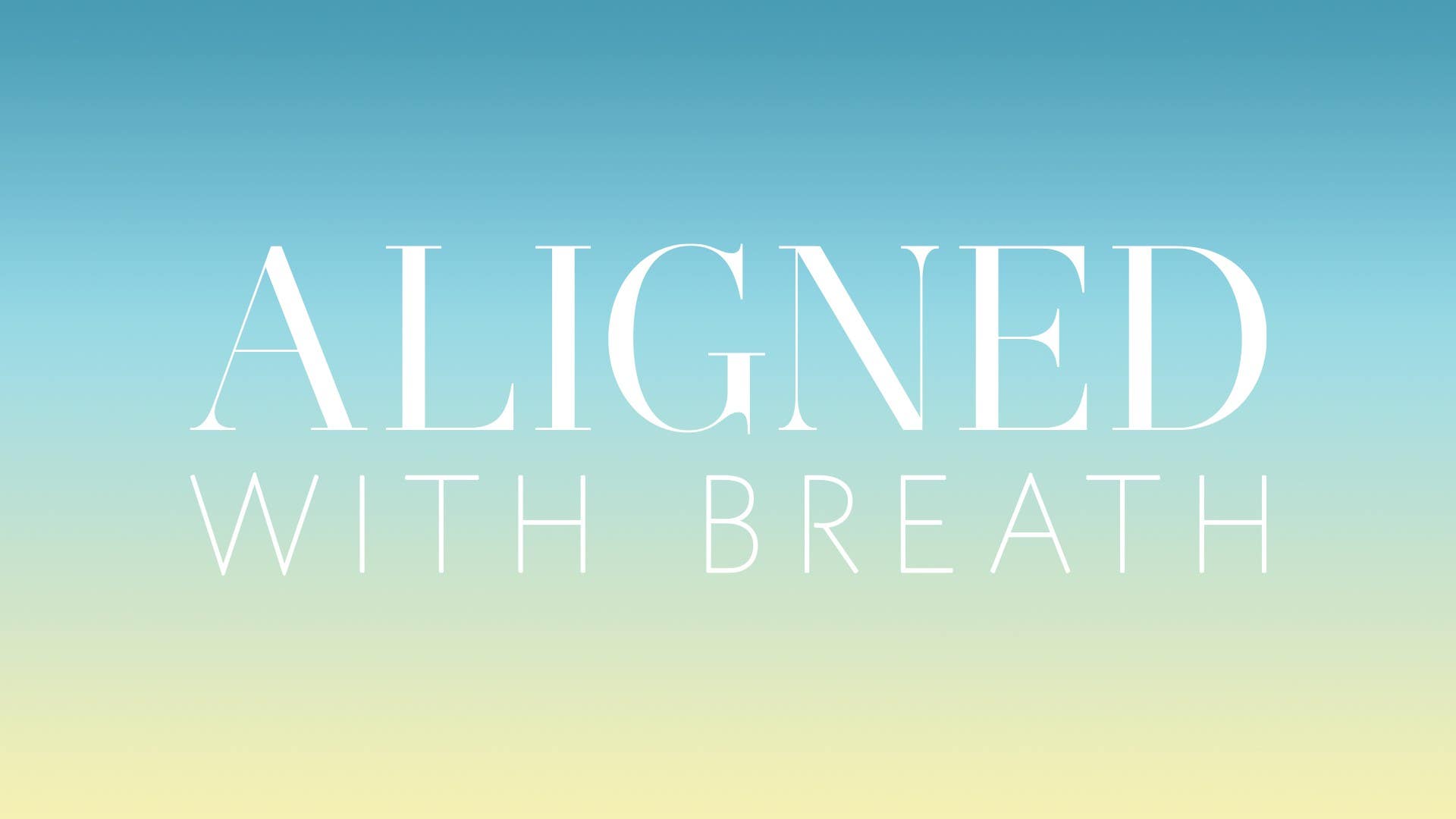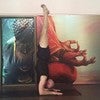Description
Transcript
Read Full Transcript
Hello and welcome. This is going to be a relatively short and slightly intense practice on a wonderful inversion called Pinchamayarasana, and it means the peacock's tail, feather, so there's a little bit of an arc to the pose, like a feather. It's an incredible pose. I've always loved this pose for the flexibility and strength to the whole shoulder girdle, the back, the core, the legs. It does take a fair amount of openness and strength also to do the pose, so just feel your way into it.
If it's new to you, please go easily. Take wonderful care of yourself. That is the most important thing. So we're going to start by opening the chest because in Pinchamayarasana, it is a chest opener. So have a block underneath your shoulder blades, and if you can work it out to have your heels right against a wall, that will be beneficial to really feel the strength of the legs, which is another integral part of the practice.
And then just let your arms open to the side and drink in this feeling of the shoulder blades being pressed into the chest by the block, a feeling that you're going to need to remember when you come into Pinchamayarasana. So the block helps the shoulder blades open and spread the chest, and you can now breathe into that space. The heels, if you have a wall right at the heels, really press the heels into the wall. If you don't have a wall, you can use an imaginary wall right now, and feel the legs very energized. When we turn upside down, we're going to need to have a real fierce lift of the legs upwards.
So get your legs awakened now. And then come up, take your blanket from underneath your head, and just slide it out. And then put your left hand onto the mat by your left ear with the fingers pointing towards your shoulders. With your right hand, take your left upper arm, roll the outer arm up, so that's externally rotating the arms. Do it strongly so you're not just kind of massaging your skin, but you're actually going in and trying to turn the bone.
And then with your hand with the bone turned, take your right hand and just pull towards the elbow, just lengthening a little through the side of the chest, through the tricep. And then we'll do the other side. Find your right hand onto the ground, kind of like a wheel pose position for the arm. Left hand holds onto the upper arm, so the tightness in the shoulders sometimes has the elbows wing out to the side, which we don't want. We want the elbow to come in towards the midline, left hand rolls the outer arm up, the inner arm down.
You might feel that all the way into the spine or inner region of the shoulder blade because this widens the back. And then again lengthen the tricep towards the elbow. And then reach both arms up overhead. Take a breath in. And as you exhale, bring your arms up and then bend your knees.
Bring your hands behind your head. Lift your head and just a few little pulses, little sit up pulses to kind of awaken the deep muscles of the core, which need to be enlivened to kick up into an inversion. And as you're pulsing up and down, see if you can engage the space in between your sitting bones. The pelvic floor is lifting up towards the low belly. The low belly is deflating towards the spine.
And a real kind of internal awareness of those core muscles and like the core of an apple, the muscles that are most central and deep in your body. And then come up to sit, turn around, and now you have a kind of delicious tricep opener. Turn onto your belly. Bring your elbows onto the blanket. And then a couple of options.
If your shoulders can handle it, put a block in between your hands. Otherwise your hands can just be in prayer. Having the block makes the stretch a little more intense. And then the elbows, we don't want them wider than the shoulders. See if you can walk them even a little bit more narrow than the shoulders.
And then the blanket, perhaps if it's on a wood floor, it can slide forward. Your head can release to the ground. Tailbone lengthens a bit towards the heels. And breathe here, feeling the whole region of the upper back, the triceps, the leg. And attempting to let the outer part of the armpit out here descend down towards the ground.
You can take your hands, whether they're in prayer or with a block, and just move them forward and backwards a little bit. And then settle them straight up. And turn your chest like as if you have that block behind your shoulder blades again. Lift your chest. And just look from the lift of the chest, look to the space in between your forearms.
Okay, if we were to flip the forearms down and the legs up, we'd be in the full pose of Pinchamayarasana. Okay, extend your arms. You just let your block, if you have it, release down. Slide back onto your forearms, interlace your fingers. Let's tuck the little finger underneath.
And then tuck the toes under, lift your abdomen, lift your pelvis, press back into forearm plank. Again, affirming the length, the strength of the legs. Squeeze the legs in towards each other. Root down through the outer hand, outer wrist, outer forearm, elbow. And then take a giant step forward, come into forearm dog pose.
And then step back, forearm plank. Step forward, forearm dog. And just a few times, walking the feet back and forward. And as you do this, you can get unmechanical about it and very aware. So what does it feel like to be in the one pose versus the other?
What's the journey in between the two experiences? Okay. And the next time you step back into forearm plank, bring your knees to the floor, press back into an extended child's pose. Breathing into the back. Come to a side bend, reaching your left arm out on the diagonal, especially the left arm.
Of course, in the inversions, we also want to have a tremendous amount of space up through the sides of the body. So right now, putting a little extra length into the left side. And then swiveling over to the other side, keeping the right hip grounded, reaching long through the right arm, feeling the expanse of the right ribs. And then come back to the center. Turn your palms to face up.
Bend your elbows. Another kind of similar position to what we've been doing. Bring your fingertips onto your upper back. And then walk your elbows forward so your pelvis will have to lift a little bit, just a little bit, to walk your elbows forward. And then glue your elbows to the mat and pull your pelvis back to your heels.
Once again, opening the triceps. And then with your fingers right there, so super close to the back of your lungs, take a few breaths, peeling your lungs, your breath with your fingertips. And then extend your arms, slide your hands back, come up, and you'll want to have your block for the next series of poses. And a couple of things, one, if your elbows tend to splay out, it's very helpful to have a belt looped armpit to armpit. And then you put it right on your upper arms.
You can do this for any of the variations. If you notice that your elbows are slipping out, which is super very common. So don't be shy to use a belt. It's going to be very important. One other thing, if your shoulders are tight, and this action is challenging for you, putting a little blanket underneath your elbows takes some of the intensity out of the shoulders.
Okay, so I'm going to show with the belt, you're going to come onto hands and knees with your toes at the wall. And then if your shoulders are tighter, put your elbows where your hands are here. If your shoulders are not so tight, you can put your forearms right where your hands are. I'm going to take the block in between the hands. The block is right into this space between the index finger and the thumb.
From here, press into downward dog with your heels at the wall, the hands rooting down. And recall the feeling of the shoulder blades being pressed into the chest from the block that we did earlier. So not, instead of being the shoulders forward, the shoulders are pressing back. Continuing to press the shoulder blades into the chest, reach your left leg up onto the wall and just pause here, really fortify the legs, feel them very long and crisp. Forearms are pressing down.
You always, there's so much downward energy in this pose, switch to the other side. You always want to, as much as you can, try to lift up and out of the shoulders, getting that space in the shoulder as best you can. So the pelvis is pulling back away from the grounding of the hands. Come down. Please take time to rest in between all these poses.
If at a certain point you feel like it's enough, take a little shavasana and carry on. Next one, we're going to take the hands like this along the block, like the outer hand is karate chops down into the block. Come back into the same position. shoulders, pressing back towards the chest. Forearms pressing strongly down.
This time we're going to step both feet up onto the wall about hip height and then straighten the legs. So L-shaped forearm stand, a tremendous amount of energy. I'm pretending like my, there's a vacuum cleaner on the ceiling and the vacuum cleaner is sucking my legs way up as the forearms press down. Step down. One more here.
We're going to turn the palms, this extreme external rotation, even through the forearms so the palms face up. I always imagine there's somebody heavy standing on my thumbs because they like to pop up, but as much rotation as possible. Try to keep the thumbs down and back into the same pose. Step onto the wall if that's in your cards, lift the thighs up and then left leg goes straight up to the ceiling into like a warrior three variation. It's tempting to let the leg turn out and fall back.
See if you can be as clean and clear about lifting the legs straight up as possible. Other leg goes straight up, internally rotates, tailbone lengthens, left thigh continues to suck up and step down. If you have a strap around your elbows, take it off and come into child's pose. You can pull the block underneath your head and then come up, slide the block between your feet, sit into Virasana and we always in yoga, we want to try to balance strength and flexibility. So those were some big strength poses for the shoulders.
Now Garudasana arms, right arm underneath the left and lift your elbows. Feel the space in between the shoulder blades and breathe into that window. From here, we're going to slide the left arm trying to keep the elbow in like it does in Pincha Mayrasana. Slide it up, bring your hand down your back, take the right arm out to the side, roll it in, slide into Gomukhasana arms and you either can clasp or hold onto your t-shirt or your hands can just rest onto your back and see if you can balance across the chest as much as possible. Sometimes to help the upper arm, the ribs, they think they're helping the upper arm, the ribs go forward so the elbow goes higher, we want to try to keep the rib cage balanced and lift the elbow straight up.
Just like we did when we were lying down earlier, outer arm rolls forward. From here slide your right hand down your back, put your right hand onto the floor, big side bend, take a deep breath in and then as you exhale, come all the way up to the center. Inhale both arms out to the side, left arm underneath the right arm, lift your elbows, just send your sitting bones, soft jaw, soft breath and then the right elbow stays close to the midline as it sneaks up and back so the top arm and the left arm widens to the side, rolls down, comes back. The right arm here is the one that's integral, this position for the pose that we're working on today. The outer arm, those triceps roll forward of the right arm, the elbow moves back and towards the midline, right elbow and the rib cage stays balanced.
And then the left hand slides down your back, put your hand onto the ground, reach your right arm up over, inhale and exhale, come all the way up. Okay, and then slide your block right to the wall and we're going to do the same hand positions as we did earlier and please feel free to use a belt still if your elbows splay out to the sides. And since the elbows wiggle a little bit, you might want to start with them a little more narrower than what you think. Legs straighten, press down firmly through the entire hand, wrist, forearm, elbow. Just lift the left leg the first time, bend the right knee, you can just do a couple of hops and see what happens.
Maybe coming up into pinch of mayurasana, keep your heels onto the wall or if you can work with balance, that's nice because that takes it out of the back, tailbone lifts, the legs lift as if the heels are pressing into a wall, left leg leads the way down. Prodigy chop hands, holding the block, right leg will lead the way up this time and it's fine just to stay here and forearm split, otherwise getting a little momentum coming up, lots of energy up through the legs, down through the arms, tailbone lifts and the chest is open so the gaze goes maybe in between the elbows or in between the forearms, right leg comes down. Slide the block back, child's pose, and how much here can you soften the whole region of the shoulders? Okay, two more. Like we did in L shape, backs of the hands onto the ground, elbows narrow, backs of the hands press, down dog, shoulder blades pressing in, the shoulders go over the elbows, left leg kicks up.
So to work with balance, the tailbone lifts, the legs come up off the wall and the legs, but the legs are slightly back of the pelvis in pinch of mayurasana like a peacock feather. Let's see, left leg leads the way down and the last one is a slightly bigger shoulder opener so if your shoulders feel taxed you might want to just pause for this last one. The palms of the hands are going to go onto the wall, wrists around the block, down dog, right leg lifts, coming up. So again, down to go up, long upper arms, long spine, long legs. Right leg leads the way down, block underneath forehead, child's pose, letting the shoulders soften completely since we're done with the shoulder work for this practice.
You can watch your heart beat, feel the heart, feel the circulation, all of the wonderful benefits of going upside down. Okay, and then come up, I'm just going to finish with a seated forward fold. I did this practice recently and left out this and I was a little spazzy for the day so crossing the legs just comfortably and coming forward and resting the forehead. And if this doesn't feel soothing to you, do something that does. We want now the whole nervous system after the excitement of going upside down, the nervous system softens inwards.
Three breaths, inhale, exhale, exhale, exhale, exhale, exhale, exhale, exhale, exhale, exhale, inhale, inhale into the soft heart which is going the opposite direction here than when it's been going for the whole practice, the front of the heart is softening, exhale. And one more breath here. And then make your way up to sit, switch the crossing of the legs which come forward just for three breaths, inhale, exhale, softening hips, legs, brain, inhale, exhale, softening hands, wrists and forearms, inhale, exhale. Use your hands to bring you up and enjoy your day with the extra bolt of energy that Pincha Mayarasana brings, thank you.
Aligned With Breath
Comments
You need to be a subscriber to post a comment.
Please Log In or Create an Account to start your free trial.













